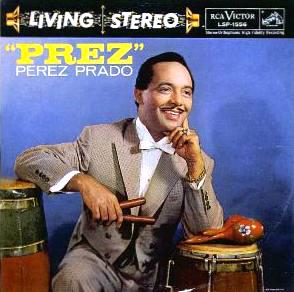Cuban/Mexican bandleader and composer. He is commonly referred to as the "King of the Mambo".
Prado was born in Matanzas, Cuba. His mother was a school teacher, his father a newspaper man. He studied classical piano in his early childhood, and later played organ and piano in local clubs. For a time, he was pianist and arranger for the Sonora Matancera, Cuba's best known musical group. He also worked with casino orchestras in Havana for most of the 1940s, and gained a reputation for being an imaginative (his solo playing style predated bebop by at least five years), loud player. He was nicknamed "El Cara de Foca" ("Seal Face") by his peers at the time.
In 1948, he moved to Mexico to form his own band and record for RCA Victor. He quickly specialized in mambos, an upbeat adaptation of the Cuban danzón. Pérez Prado's mambos stood out among the competition, with their fiery brass riffs and strong sax counterpoints, and most of all, Prado's trademark grunts (he actually says "¡Dilo!", or "Say it!", in many of the perceived grunts). In 1950, arranger Sonny Burke heard "Qué rico mambo" while on vacation in Mexico and recorded it back in the U.S. as "Mambo Jambo". The single was a hit and Pérez Prado decided to profit himself from the success and tour the U.S. His appearances in 1951 were sell-outs and he began recording U.S. releases for RCA Victor.
Prado is the composer of such famous pieces as "Mambo No. 5" (later a UK chart-topper for both Lou Bega in 1999 and cartoon character Bob the Builder in 2001) and "Mambo No. 8". At the height of the mambo movement, in 1955, Pérez Prado hit the American charts at number one with a cha-cha Version of "Cherry Pink And Apple Blossom White" (composed by the Frenchman Louiguy). It held the spot for 10 consecutive weeks. Prado had first covered this title for the movie Underwater! in 1954, where Jane Russell can be seen dancing to "Cherry Pink". In 1958, Pérez Prado reached number one with one of his own compositions, "Patricia". This piece was later featured in the striptease scene in Federico Fellini's movie La Dolce Vita.
His popularity in the United States matched the peak of the first wave of interest in Latin music outside the Latino communities during the 1940s, 1950s and early 1960s.
Pérez Prado also appeared in films in the United States and Europe as well as in Mexican cinema, constantly wearing his trademark goatee, as well as turtle-neck sweaters and vests.
With the end of the 1950s, his success declined and the years gave way to new rhythms, like rock 'n roll and then pop music. Prado's association with RCA ended in the 60s and his recorded output was mainly limited to smaller labels and recycled Latin-style anthologies.
In the early 70s, Pérez Prado permanently returned to his apartment off Mexico City's grand Paseo de la Reforma to live with his wife and two children, son Dámaso Pérez Salinas (also known as Pérez Prado, Jr.) and daughter Maria Engracia. Despite his fading star in the US, his career in Latin America was stronger than ever. He still toured and continued to record material which was released in Mexico, South America, and Japan. He was revered as one of the reigning giants of the music industry and was a regular performer on Mexican television. In Japan, a live concert recording of his 1973 tour was released on LP in an early 4-channel format.
In 1981, he was featured in a musical revue entitled Sun which enjoyed a long run in the Mexican capital. His last American appearance was at Hollywood on September 12, 1987, when he played to a packed house. This was also the year of his last recording.
Persistent ill health plagued him for the next two years and he died of a stroke in Mexico City on September 14, 1989, at the age of 72.
During his lifetime, a cast of musical luminaries passed through his orchestra. These included Cuban singer Beny Moré, trumpeter Pete Candoli, bongo and conga drummer Armando Parazo, percussionists Johnny Pacheco and Mongo Santamaria, and reedman (later bandleader) Rene Bloch.
The mambo, reinvigorated under the name salsa, is still the signature dance of Latin popular music and Pérez Prado, Jr., continues to direct the Pérez Prado Orchestra in Mexico City, today.
